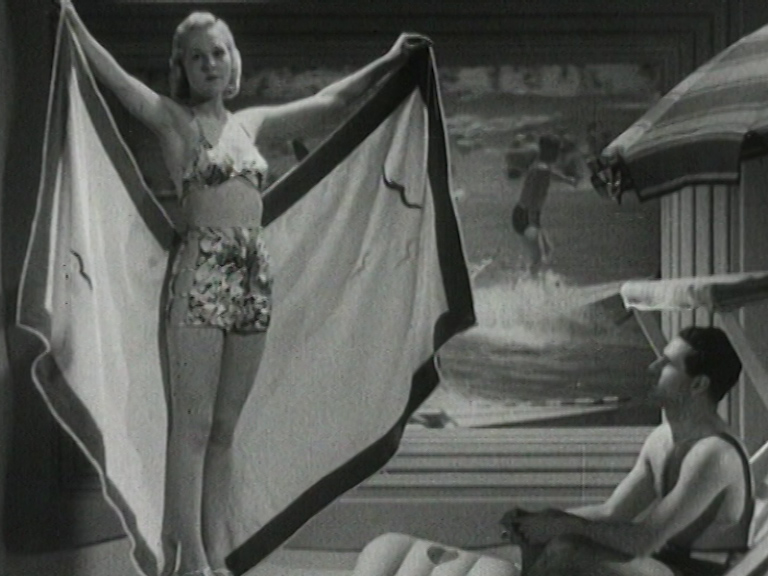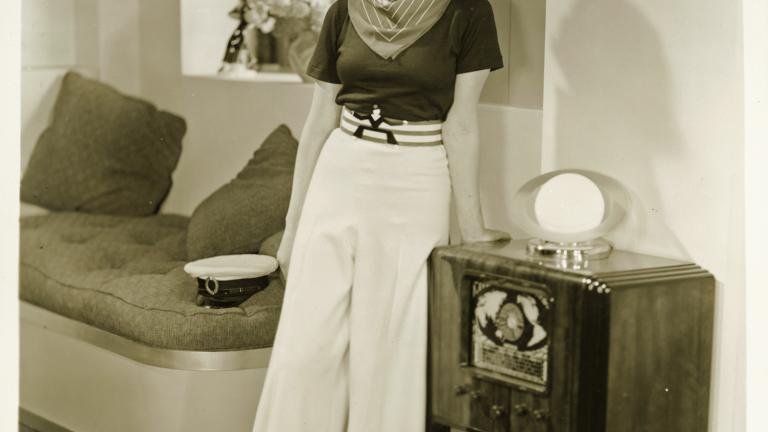NFSA curator Jenny Gall shines a spotlight on Mavis Ripper, a pioneer of Australian costume design for film and theatre.


NFSA curator Jenny Gall shines a spotlight on Mavis Ripper, a pioneer of Australian costume design for film and theatre.
Mavis Ripper (1908-1989) was a designer and portrait painter trained at the National Gallery of Victoria. When she was invited to design for Cinesound Film Productions, it was the opportunity of a lifetime to elevate her garments to a new and glamorous status.
From 1934, Mavis began designing large numbers of costumes for musical theatre productions such as Something Different and Joanna and registered her new company, 'Mavis Ripper Pty Ltd., drapers and general warehousemen, costumiers etc.' at 22 Collins Street.
In January 1936, Sydney-based Cinesound announced that Mavis would design the costumes for It Isn’t Done (1937). Shirley Anne Richards was the young star of the film. The Sydney Morning Herald of 14 October 1936 described the colour of Richards' dress (which was not visible in the black-and-white film) as 'an evening gown of pastel green stiffened net, mounted over gleaming taffeta'.
Mavis took the measurements of each of the actresses while visiting Sydney in pre-production and made canvas mounts to fit each model. The gowns were made in Melbourne then returned to Sydney.
Most challenging for Mavis was designing clothes for Nellie Ferguson in the role of Shirley Anne Richards' mother, Mrs Blaydon, as the outfits had to reflect the poor taste of the newly rich. In an interview with the Daily Telegraph of 14 October 1936, Mavis felt it necessary to clarify that the gowns reflected the fictional character, not her own impeccable style:
'Words fail me when I bring these out… it was one of the hardest jobs I’ve ever done to design these. Floral chiffon blouses with woollen suits and cabbage-like posies on evening frocks…why, they’re pre-war!'
Mavis’s costumes for the 1937 Cinesound film Lovers and Luggers inspired the garments she offered clients. For four guineas, a customer could purchase a gold lamé cocktail frock with black velvet jacket – an ensemble similar to that of Elaine Hamill, star of Lovers and Luggers.
As the Melbourne Age, 31 July 1937, reported: 'There is no doubt at all that the screen today is the greatest influence on fashion, and that women study the lovely creations designed for their favourite star so that with each new production fashions are born that sweep throughout the world.' Shirley Ann Richards' signature outfit was a white trouser suit in which the actress made her first appearance.
Trousers defined Lorna’s independence in contrast to the vacuous and duplicitous socialite, Stella (Elaine Hamill). Similar tailored sportswear was a hallmark of Mavis’s salon collections, as seen in the clip below from Lovers and Luggers featuring Richards:
Scene from Lovers and Luggers, 1937. Cinesound-Movietone Productions. Starring Lloyd Hughes as Daubenny Carshott and Shirley Ann Richards as Lorna Quidley. NFSA ID: 7585.
The Argus hailed Mavis Ripper as the first woman designer of screen fashions in Australia, enthusing: 'Australian producers realise the appeal of fine dressing to the women of their audiences … The dressing of Australian films is rapidly becoming distinguished.' The article featured the wedding dress Mavis designed for Richards to wear in the other Cinesound hit of 1937, the drama Tall Timbers.
Cinesound’s 1938 production, Dad and Dave Come to Town, provided Mavis with a perfect opportunity to showcase her designs in the spectacular fashion parade at the climax of the film. The production purchased 150 yards of white chiffon to construct 5 circular-cut skirts for a spectacular dance routine.
With a staff of 50 seamstresses and assistants, Mavis created 45 outfits for the parade worn by 18 mannequins, valued at a total of £2,000. Sports clothes were a feature of the parade. A riding habit, skating outfit, skiing outfit and daring bikini were paraded against moving image landscapes. These 'live' backgrounds were a first in movie production, described by the Camperdown Chronicle of 4 October 1938 as 'the most original idea ever used in fashion presentation'. Connecting her movie persona with her Melbourne salon, Mavis hosted the guest American starlet from Dad and Dave Come to Town, Leila Steppe, at a Myer Fashion Tea in September 1938 as she modelled a selection of glamorous in-house fashions.

A scene from Dad and Dave Come to Town, 1938. Cinesound-Movietone Productions. Starring Shirley Ann Richards as Jill and Fred MacDonald as Dave. NFSA ID: 7581.
As costume historian Margaret Maynard has noted in Out of Line: Australian Women and Style, with the outbreak of war in 1939, Mavis campaigned to promote the use of Australian-made fine woollen fabrics in fashion. She delivered her manifesto in the Australian Women’s Weekly of 9 March 1941:
'We have the designers, the artists, the manufacturers and the craftsmen, and our own individual type of woman to wear the fashions they create.'
Wartime austerity eventually thwarted Mavis’s career until in 1945, Columbia Films announced their production about the famous aviator Charles Kingsford Smith with Mavis as wardrobe supervisor and a budget of £4,000 for costumes, including 16 outfits for Muriel Steinbeck who played 'Lady Smithy'. The film Smithy was her final commission. On 23 August 1947 Mavis exchanged fashion for diplomacy when she married Jean-Pierre Saurer, Vice Consul for Switzerland in Sydney.
You can view a selection of Mavis Ripper's costume designs in the following image gallery:

Production still from the film It Isn't Done (1937) featuring Shirley Ann Richards (as Patricia Blaydon) standing in a hall, wearing an evening gown with a borzoi hound at her feet. NFSA ID: 353726.
Click to open image.

Production still from It Isn't Done (1937). Nellie Ferguson (Mrs Blaydon) practices her curtsey in front of a mirror as Shirley Anne Richards (Patricia Blayden) looks on. NFSA ID: 576583.
Click to open image.

Production shot from the film Smithy (1946), showing people dancing in a ballroom while a camera crew on a mobile crane film the scene. NFSA ID: 765254.
Click to open image.

Shirley Ann Richards in a still from the film Lovers and Luggers (1937), dressed in nautical attire and leaning on a radiogram. NFSA ID: 567004.
Click to open image.

Dad and Dave Come to Town (1938): cast portrait. Bert Bailey (Dad Rudd) and Connie Martyn (Mum) seated on sofa; Fred Macdonald (Dave) sitting on right arm of sofa; standing behind (L-R): Billy Rayes (Jim Bradley), Marshall Crosby (Ryan Snr), Shirley Ann Richards (Jill), Alec Kellaway (Entwistle) and Muriel Ford (Myrtle). NFSA ID: 347614.
Click to open image.

Production still from Dad and Dave Come to Town (1938), featuring Jean Medaras ('Cinesound Girl') sitting on a stepladder and posing in a bathing suit and cloak, from the film's fashion parade sequence. NFSA ID: 347840.
Click to open image.
Mavis Ripper’s name has faded from the prominence she enjoyed in Australian cultural life in the inter-war years, but her designs for both film and fashion helped define an assertive and enduring Australian style distinct from European archetypes.
Main image: Production still from It Isn't Done (1937), featuring a film set of a ballroom scene with many actors in formal dress. NFSA ID: 579634.
The National Film and Sound Archive of Australia acknowledges Australia’s Aboriginal and Torres Strait Islander peoples as the Traditional Custodians of the land on which we work and live and gives respect to their Elders both past and present.